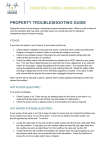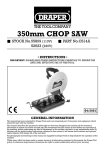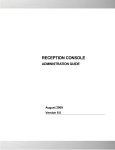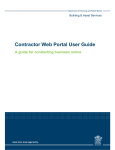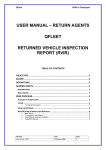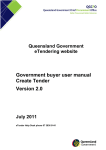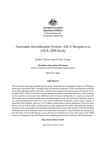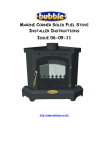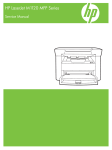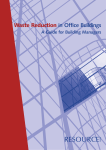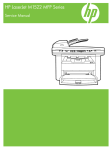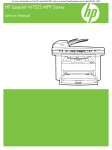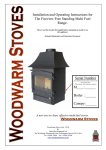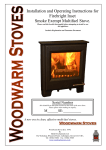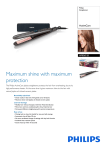Download Building user guide (BUG) - Department of Housing and Public Works
Transcript
Accommodation Office Office Accommodation Management Framework Guideline 4: Occupancy Sample document Building user guide (BUG) August 2009 Sample document Building user guide ii Contents 1.0 Purpose 1 Advantage to building user 1 Overview of Strategic Energy Efficiency Policy 2 2.0 Overview of Carbon Reduction Strategy 2 3.0 Overview of Sustainable Office Building Rating Policy 2 4.0 Building owner commitments 3 4.1 Healthy work environment 3 4.2 Low energy use and greenhouse gas emission 3 4.3 Building Management System (BMS) 3 4.4 Facilities maintenance officer 3 4.5 Building services coordinator 4 4.6 Building security committee 4 4.7 Mail delivery and screening 4 4.8 Transport options 4 4.9 Efficient water management 5 5.0 4.10Materials and waste policy 5 4.11Cleaning services 6 Site description 7 6.0 Building management contacts 8 7.0 9 Supply index 8.0 Tenant’s commitments 10 8.1 Energy conservation 10 8.2 Owner approval for fitout 10 8.3 Building act compliance 12 8.4 Floor loadings 12 8.5 Lighting and power 12 8.6 Water 13 8.7 Finishes / joinery / workstations and general office furniture 13 8.8 Floor finishes 13 8.9 Kitchen fittings and appliances 14 8.10Office equipment 14 8.11Demolition and construction waste 14 8.12Cleaning 14 8.13Occupant Emergency Progam 15 8.14Key / keys applications 15 8.15Access 15 8.16First aid 15 9.0 Useful links Office Accommodation Management Framework 16 Guideline 4: Occupancy Sample document Building user guide 1 This sample document has been specifically developed by the Accommodation Office for the management of government owned and leased buildings. It is designed to provide information and access to material and support tools to assist tenant departments to meet their obligations under the government’s Strategic Energy Efficiency Policy, effectively manage the space they occupy, and the overall operations of the building they occupy. It is envisaged that building user guides will be written for each government-owned building by the asset/ property, according to the distinctive operational requirements of each property. To obtain a copy of a particular property’s building user guide please email [email protected]. Building user guide Purpose The purpose of the Building user guide is to provide details regarding the everyday operation of a typical government office building. The Energy Strategy Design (ESD) section of the guide provides guidance on the green initiatives designed into the building. It is provided so that the building occupants can use the building correctly while minimising energy use. The guide will assist: • property managers to understand in detail what they need to do to operate the asset efficiently and to assist in the identification of further tuning that may be necessary to continuously improve performance and respond to future changes • contractors to understand how to service and maintain the particular systems not only for reliable operations, but also for energy and water efficiency • occupants to understand any limitations that they must work within to maintain the design performance • future effective fit out / refurbishments streamlining the building owner approvals for the building to conform with the Strategic Energy Efficiency Policy for Queensland Government Buildings, Sustainable Office Building Rating Policy and Carbon Reduction Strategy. Advantage to building user The Building user guide is an operational tool that will assist facility officers, project officers and tenants in the day to day operation of their occupied tenanted space and will assist in: • informing staff on facility management practices, security and waste processes • informing and motivating staff to embrace a new approach to process and cultural change within the workplace • reducing time in development and delivery of fitouts • providing more efficient communication between staff, service providers, and building owner thus enhancing service delivery outcomes • providing support to the relocation/change management process • providing a higher standard of maintenance by focusing on more effective strategies, such as compliance and energy efficient provisions in the built environment • reduction in energy consumption allowing savings that can provide for more efficient building systems, capital works and fitouts • provision of healthy work environment. Office Accommodation Management Framework Guideline 4: Occupancy Sample document Building user guide 2 1.0 Overview of Strategic Energy Efficiency Policy As part of the Queensland Government Climate Smart 2050 initiative to reduce energy consumption and greenhouse emissions for all government buildings, the Strategic Energy Efficiency Policy (SEEP) was implemented to provide mandatory energy reduction targets and timeframes, to ensure efficient use of energy and to mandate energy reporting requirements for government agencies. Under the SEEP the Department of Public Works is required to: • reduce its energy consumption across the portfolio by 5 per cent by 2010 and by 20 per cent by 2015 using a 2005-2006 consumption levels as a comparative baseline • develop and implement an energy management plan • provide ongoing recording and monitoring of energy consumption • incorporate energy management principles in the construction of new buildings, and wherever practicable during refurbishment, renovation and maintenance works for existing buildings • identify and apply energy conservation and management measures through procurement practices, technological solutions and staff educational/training programs. 2.0 Overview of Carbon Reduction Strategy Climate Smart 2050 also committed the Queensland Government to achieve carbon neutrality for government owned buildings by 2020. The Carbon Reduction Strategy sets out the target to be achieved by: • implementing mandatory energy reduction targets as indicated in the Strategic Energy Efficiency Policy • mandating air-conditioning temperatures at 24°C for summer operation • switching off all non-essential computers and other office equipment outside of normal office hours • constructing new office buildings to aim for a minimum a 4½ star NABERS (National Australian Built Environment Rating System—previously referred to Australian Building Greenhouse Rating (ABGR)), rating with refurbishments to aim to achieve, where possible, a 4½ star NABERS rating • purchasing accredited carbon offsets only after energy consumption has been minimised • developing and maintaining of a central register of carbon emissions for government owned buildings • implementing educational programs to promote energy conservation and carbon reduction. 3.0 Overview of Sustainable Office Building Rating Policy The Sustainable Office Building Rating Policy outlines the Department of Public Works’ preferred sustainable building rating systems for environmental assessment, benchmarking of targets for energy, water and natural resource conservation to be used when designing, developing and managing the office building portfolio. The department will target the following: • a minimum of 5 star Green Star rating for its new office buildings including fit outs (for fit outs and refurbishments within existing buildings in excess of 2000m² the target will be 4 star Green Star) • a minimum of 4½ star NABERS Office Energy Rating for it new buildings, refurbishments, fit outs and for leases in excess of 2000m² in new office buildings • a minimum of 4 star NABERS Office Water rating, 3 Star NABERS Office Waste rating and 3 star NABERS Office Environmental rating in all buildings. Office Accommodation Management Framework Guideline 4: Occupancy Sample document Building user guide 3 4.0 Building owner commitments 4.1 Healthy work environment The Accommodation Office has a commitment to provide a healthy and safe work environment by use of: • regular maintenance testing and recalibration of base building services • prompt action in response to performance issues • monitoring and maintenance of indoor temperature at set summer and winter ranges • regular HVAC tests for contaminants and removal of contaminants • offsite storage for all hazardous material, such as paint,and cleaning products. • all plant monitored and maintained according to statutory requirements and building operation and maintenance manuals. 4.2 Low energy use and greenhouse gas emission Lower energy use and greenhouse gas emissions by: • monitoring and reporting of building energy use and greenhouse gas emissions • conducting NABERS energy assessments annually for buildings • reducing energy use via the use of Energy Performance Contracts and other energy efficiency projects • metering of building energy consumption and water use including cooling towers • implementing staff educational programs to promote energy conservation. 4.3 Building Management System (BMS) Office buildings in the Department of Works portfolio generally operate lighting and air conditioning plant between the hours of 7am and 6pm Monday to Friday. These systems are generally controlled by the building management systems. Department of Public Works will continue to investigate and implement energy saving strategies for the control of building lighting and air-conditioning systems. 4.4 Facilities maintenance officer The role of the facilities maintenance officer is to represent the building owner on site to ensure the provision of all relevant services are provided in order to maintain the operational effectiveness of the base building. A primary function of the facilities maintenance officer is to manage building maintenance and minor works within the building. Office Accommodation Management Framework Guideline 4: Occupancy Sample document Building user guide 4 4.5 Building services coordinator The building services coordinator monitors and provides access for all occupants, contractors and visitors to the building. The building services coordinator is the first point of contact for maintenance issues. The building services coordinator is the chief fire warden and responsible for conducting training for occupants in fire evacuation procedures. For information and fire and evacuation plans visit: www.fire.qld.gov.au/buildingsafety/legislation.asp The building services coordinator also monitors and provides access to the car park, including regular auditing of its usage. 4.6 Building security committee Many CBD buildings have a building security committee that meet on a regular basis to determine security levels and occupants’ requirements. The committee may review building opening hours, access requirements and security levels. 4.7 Mail delivery and screening Mail screening was introduced in July 2006 as a whole-of-government service designed to intercept hazardous materials that could be sent in mail to government agencies. The mail screening service is performed by Decipha Pty Ltd, (a wholly owned subsidiary of Australia Post) at its West End premises on a fee for services basis, which is billed monthly to all agencies that use the service. For information about the specific mail security arrangements for your building, contact the building services coordinator in your building. 4.8 Transport options The building owner has provided: • secure car parking • secure bike storage • showers and change facilities and storage for cyclists • spaces for cars, scooters, motorcycles and bicycles. Agencies that occupy space in the building have first priority in proportion to their office space allocation to lease car parking bays at market rates from the Department of Public Works. Building Car park bays Motorcycle bays Bicycle racks Office Accommodation Management Framework Showers Lockers Guideline 4: Occupancy Sample document Building user guide 4.9 5 Efficient water management The Accommodation Office is committed to ensuring the efficient use of water in its office portfolio. Specifically the Accommodation Office: • monitors water usage including cooling towers usage • inspects for leaks and other base building performance issues • investigates new technologies designed to minimise water usage. Water saving devices have generally been installed in all facilities including showers, urinals, pans and taps. For water efficiency rating refer to the Water Efficiency Labelling Scheme (WELS) scheme: www.waterrating.gov.au For further information concerning the Department of Public Works’ water conservation program, Water Smart Buildings, refer to: www.build.qld.gov.au/tdd/climate/water_management.asp 4.10 Materials and waste policy The Accommodation Office is committed to the minimisation of waste going to landfill. To achieve best practice outcomes Accommodation Office has provided: • facilities for separate storage and recycling of paper, cardboard, containers and food waste. • separate bins for shredding of confidential material (obtainable through QBuild Contract Management Services) • regular monitoring and reporting of waste going to landfill • systems for recycling of items such as toner cartridges, fluorescent tubes, batteries and mobile phones. What can be recycled? Almost all office waste (aside from food/organic waste) can be recycled. Below is a list of products and materials you should recycle in your office: • Paper recycling – All types of office use – Magazines – Newspapers – Manila folders – Dividers – Envelopes • General recycling – Toner cartridges – Gloss bottles – Plastic bottles – Milk cartons – Aluminium cans – Any other container/materials displaying a ‘recyclable’ symbol. Office Accommodation Management Framework Guideline 4: Occupancy Sample document Building user guide 6 When is recycling collected? Recycling will be collected from the designated recycling area on each floor daily. Toner cartridges will be collected from designated bins on each floor on telephone call to contractor direct as displayed on bins. The waste/recycling contractor will collect the entire building’s recycling from the storage area daily to it’s facility for processing. Confidential bins are shredded on site. Waste management Waste to landfill benchmark Paper recycling benchmark Co-mingled recycling benchmark 4.11 Cleaning services Cleaning services are aligned with the achievement of good environmental objectives through specifying: • use of natural, solvent-free and hydrocarbon-free cleaning products • compliance with waste management and energy efficiency policies • relevant cleaning and maintenance procedures for specialist ‘green’ products including environmentally safer pest control • an educational program for tenants and cleaners to ensure that there is effective communication on the desired outcomes for an environmentally effective environment • annual carpet shampoo • quarterly pest control. Office Accommodation Management Framework Guideline 4: Occupancy Sample document Building user guide 7 5.0 Site description Description of the building’s unique facilities Basic Functions Details Functionality Features Energy initiatives Ventilation Cooling system Electrical system Lighting Domestic hot water Recycling programs Schedules for waste removal Security lights Environmental Heritage Office Accommodation Management Framework Guideline 4: Occupancy Sample document Building user guide 8 6.0 Building management contacts Contractor register for base building services Name Service provided Phone Email Office Accommodation Management Framework Guideline 4: Occupancy Sample document Building user guide 9 7.0 Supply index An index of all suppliers used in the tenancies and base building including specifications of all items used, contact details, warranties, and any Product Stewardship or recycling instructions for the end of each product’s life. An example would be carpet, paint, tiles, light fittings, furntiture and fixtures. Name Service provided Office Accommodation Management Framework Phone Email Instructions Guideline 4: Occupancy Sample document Building user guide 10 8.0 Tenant’s commitments 8.1 Energy conservation The Department of Public Works is committed to the government’s Carbon Reduction Strategy to improve energy efficiency and reduce carbon emissions in government buildings. To comply with this state government policy, tenants will be encouraged to implement the following practices within their tenancies: • Switch off all non essential computers and other office equipment outside of normal working hours. For prolonged periods turn off at the wall as standby mode on equipment will still consume energy. • Develop and implement energy smart strategies and technologies in all new fit outs. • Improve computer use practices and hardware with energy saving features to assist with energy reduction targets. • Utilise green procurement practices in line with state government procurement policies. • Where possible monitor energy usage and encourage staff participation in minimising energy use. The department is committed to reducing energy consumption by effective lighting and HVAC management. To reduce energy use, tenants should specifically: • ensure that lights and air-conditioning are turned off when not in use, where individual controls have been installed • promote the use of smart lighting controls such as occupancy sensors and timers to automatically turn lights off during and after business hours • avoid over-lighting of tenancy space to highlight displays • promote the use of natural light • maintain and clean light fittings and tubes as per manufacturer’s guidelines to ensure levels are maintained at peak performance • remind staff to be energy aware and turn off services when not required through the use of posters and other media • install energy efficient lights and lamps when fittings need replacement or upgrading • control conference/training room supplementary air-conditioning units by occupancy or time based controls and set temperature to 24°C during summer operation. There is a cost to tenants to operate building air-conditioning services after hours, which may vary from building to building. An after hours air-conditioning report is produced monthly by the building services coordinator and sent to the property manager for recovery of costs from the tenant. 8.2 Owner approval for fitout The Accommodation Office aims to support the following Sustainable Office Building Rating Policy targets: • A minimum of 5 star Green Star rating for new government-owned office buildings including fit outs. For fit outs and refurbishments within existing buildings in excess of 2000m² the target will be 4 star Green Star. • A minimum of 4½ star NABERS Office Energy Rating for new government-owned buildings, refurbishments, fit outs and for leases in excess of 2000m² in new office buildings. • A minimum of 4 star NABERS Office Water Rating, 3 star NABERS Office Waste rating and 3 star NABERS Office Environmental rating. Office Accommodation Management Framework Guideline 4: Occupancy Sample document Building user guide 11 Accredited assessors shall be engaged during the design and as-built stages of the projects to enable rating assessments to be completed for compliance to this policy. Green Star — Office Design and Green Star — Office As Built ratings to be submitted in the building owner approval application. Tenants are actively encouraged to liaise with the building owner in the early stages of fit out planning to avoid possible delays in the approval process through failure to comply with the Sustainable Office Buildings Rating Policy. For Green Star applications, use of the correct rating tool is essential to comply with the requirement of this policy. This table shows which rating tools the policy recommends for Green Star certification Application Green Star rating tool New buildings Green Star — Office Design Green Star — Office As Built Refurbishment of buildings Green Star — Office Existing Building Green Star — Office As Built Office fit outs of new buildings Green Star — Office Interiors Green leases, office fit outs and existing building refurbishments Green Star — Office As Built Green Star — Office Interiors Fit out works Green Star — Office Interiors (under this toolbar requires NABERS energy rating for the tenancy area) Base building works Green Star — Office As Built The Green Star rating tools can be downloaded from the Green Building Council of Australia’s website: www.gbca.org.au/green-star/rating-tools/ Information concerning NABERS (the National Australian Built Environment Rating System) can be obtained from: www.nabers.com.au Additional information concerning these policies is obtainable from the following Department of Public Works website using the links below: Strategic Energy Efficiency Policy and Carbon Reduction policy: www.build.qld.gov.au/tdd/climate/energy_management.asp Environmental Rating Systems overview: www.build.qld.gov.au/downloads/bpu/bapf_enviroratingsystems.pdf Office Accommodation Management Framework Guideline 4: Occupancy Sample document Building user guide 12 8.3 Building act compliance Tenants are required to ensure that all proposed relevant fit out work should comply with the current Building Code of Australia, Australian Standards and Statutory requirements. The building owner requires that: • Plans must be fully compliant and certification provided that works / alterations are in no way detrimental to building services and systems. • Comments in relation to the technical capacity of the building are to be included. • Where necessary all disciplines including fire, electrical and mechanical should review and sign off on plans. • Any proposal involving structural penetrations must include an independent certification and/or inspection by a structural engineer external to Project Services, as per our standard building owner requirements. Similarly, any intention to install safes/compactus units must be supported by load bearing tests and signed off by a structural engineer. These certificates should accompany the plans sent to the property manager for preliminary or final approval. • Where the fitout involves installation of meeting, interview or training rooms the plans must be reviewed by a mechancial engineer to ascertain if suplementary air-conditoning is required. If it is intended to install supplementary air-conditioning an assessment must be undertaken to ensure that it will not be detrimental to the performance of the main plant. Issues associated with vibration and noise from larger supplementry systems must be assessed and documentated and necessary stability and acoustic measures taken. • Training rooms involving the installation of multiple computers are to be assessed by electrical and mechancial engineers to ensure that there is sufficient capacity to service the electrical and heat loads; • Where an air-balance is required as part of the mechanical works a certificate must be provided on completion of works indicating the works have been completed. • Where an alternate fire solution has been installed (e.g. VESDA (very early smoke detection apparatus)), the building’s Maintenance Certificate is to be updated and provided to the asset/ property manager following completion of works. • Where an on-line/interactive fire and evacuation training system is implemented at a building the on-line and hardcopy floor plans are to be updated, at the tenants cost, to reflect fitout changes. • RCD’s (residual current device) should be installed by the tenant and the building owner will maintain them. 8.4 Floor loadings Installation or moving of heavy furniture such as safes or compactus requires a certificate from structural engineer to the property manager prior to commencement of work. 8.5 Lighting and power Fit out lighting accounts for more than 20 per cent of the average tenant’s energy costs and represents the largest single opportunity for energy savings. Efficient lighting also reduces the heat load on the base building air conditioning, resulting in further indirect cost savings. The tenant should minimise non-standard and inefficient ‘feature’ lighting in it’s tenancy without interfering with existing building lighting systems. Office Accommodation Management Framework Guideline 4: Occupancy Sample document Building user guide 13 For efficient lighting it is reccommended that: • efficient fluorescent, electronic ballast (less than 10w/m²) such as T8 or T5 are used for general office lighting • Compact fluorescent or LED (light emitting diodes) are used for special purpose lighting • Lighting is controlled via the Building Management System, where installed, including the use of other automatic control systems using timers/occupancy detection at a local level. Green Star credit initiatives such as daylight control, lighting zoning, levels and load density to be applied where practicable. It is a Department of Public Works requirement that all tenant lighting will automatically turn off after normal business hours. After hours lighting requests to be time based for a maximum of 2 hours. Energy sub metering is to be implemented for substantive energy uses of 25kVa or greater with effective methods for monitoring the consumption data. This includes computer rooms, supplementary air-conditioning units used for computer rooms/meeting rooms and other high consumption load not normally used for an office environment. Where switchboards require major modifications and/or replacement, separate sub metering and monitoring of floor tenant lighting and power will need to be provided. Refer to the Energy section of the Green Star — Office Interiors rating tool for specific requirements (available from www.gbca.org.au/green-star/rating-tools/) 8.6 Water Buildings may be monitored for water consumption. Occupants are expected to minimise water consumption by: • taking 4 minute or shorter showers • turning off all taps when not in use • reporting any leaks or unnecessary water use identified in the building to the facilities maintenance officer, building services coordinator or property manager. 8.7 Finishes / joinery / workstations and general office furniture Where possible the tenant agrees to reuse existing joinery, workstations and general office furniture. Where it is not possible the tenant should undertake to source eco-preferable products that use low emission composites, laminates, finishes and glues. Further information concerning environmentally friendly products can be found at: www.ecospecifier.org 8.8 Floor finishes The building has a standard carpet provided through the Carpet Replacement Program. It is preferred that the fit out either retains the existing floor finishes or replaces existing with a similar modular carpet which has the ability to be reconditioned and/or with recycled content and a high level of recycled product in it’s manufacture. Any new carpet must have low emissions and be approved by the building owner. Office Accommodation Management Framework Guideline 4: Occupancy Sample document Building user guide 14 8.9 Kitchen fittings and appliances Where a new kitchen is being installed as part of the overall refurbishment it is necessary to ensure that there is a properly installed waste outlet to allow excess water to escape should there be flooding. Also any dishwashers should be installed correctly to the plumbing. In addition: • it is preferred that all dishwashers, fridges, and other appliances are 4 star energy rated • rapid boil kettles should be used instead of zip boilers • all electrical appliances (such as kettles, toasters, radios, microwaves refrigerators) are checked and tagged on a regular basis or in the case of earth leakage circuit breakers, tested every 6 months by qualified persons under the Electrical Safety Act. 8.10 Office equipment Ensure your computers and office equipment are Energy Star enabled, so that they ‘go to sleep’ and use less energy when they’re not being used. In addition: • utilise multi-function equipment to save energy, where practical • compare the energy use of all the different power modes (e.g. active, standby, sleep, deep sleep) • instruct all staff to ensure all equipment is turned off at the end of the day • use green procurement practices in line with new state purchasing policies • promote double sided photocopying • recycle and buy recycled ink cartridges. For more information on energy efficiency refer to the following web sites: Australian Government’s energy rating scheme: www.energyrating.gov.au Australian Government’s Department of Climate Change: www.climatechange.gov.au 8.11 Demolition and construction waste During the demolition and construction of fit outs or any minor refurbishments it is required that rubbish and furniture be removed daily and in an environmentally appropriate manner. 8.12 Cleaning To maintain a clean office environment, tenants need to: • ensure that occupants use recycle bins in kitchens • take care that the bins located at the desks do not become receptacles for food scraps (this assists in reduction of fruit fly and prolongs life of bin liners reducing in the overall supply and demand for bin liners) • report to the building services coordinator on any spills for immediate clean by day cleaner. Office Accommodation Management Framework Guideline 4: Occupancy Sample document Building user guide 15 8.13 Occupant Emergency Progam Tenants are required by legislation to participate in an Occupant Emergency Program. Evacuation plans should be located on every floor near the fireboards. Fire boards should be installed near the warden intercom point (WIP) phone or adjacent to a fire exit. The board should contain: • 1 yellow helmet for floor warden • red helmets for wardens (1 warden per 20 persons with a minimum of 2) • first aid helmet (green or white with green cross) • 1 loud hailer • 1 torch • first aid kit • dry powder fire extinguishers (as dictated by Australian Standards). These are part of the tenant fit out and are required by legislation to be maintained by the tenant department. They should be part of ‘make good’ under the Occupancy Agreement. 8.14 Key / keys applications All keys are to be ordered on a Keys Locks and Application Form authorised by the property manager for the master key and all other keys verified by the building services coordinator. They will be consistent with the building master key system. Keys for access to the electrical risers and plant rooms are held by the building services coordinator on the master key system and are not for general access. They can be attained for contractor work on a ‘sign in’/‘sign out’ basis. 8.15 Access In many buildings, fire training for evacuation procedures is a prerequisite for an access card being supplied to the premises and is conducted by the building services coordinator and forms part of the induction program. All contractors and visitors must sign in and out to access the building. Tenants should be aware as to what measures are in place and the level of identification required for staff to gain access to premises. In most buildings government identification needs to be displayed to gain access. When access cards are lost there will be a fee applicable for its replacement. 8.16 First aid Should the tenants require urgent first aid they should contact the building services . All other first aid requirements can be met by a first aid officer provided by their department and access to first aid facilities within the building including a first aid/carer’s room with first aid supplies within. Office Accommodation Management Framework Guideline 4: Occupancy Sample document Building user guide 16 9.0 Useful links Department of Public Works Office Accommodation Management Framework: www.build.qld.gov.au/qgao/oamf/ Ecologically Sustainable Development: www.build.qld.gov.au/qgao/office/esd.asp Capital Works Management Framework: www.build.qld.gov.au/bpu/cwmf/ Maintenance Management Framework: www.build.qld.gov.au/bpu/mmf/ Occupancy Agreement: www.build.qld.gov.au/downloads/qgao/occupancy_agreement.pdf Strategic Energy Efficiency Policy: www.build.qld.gov.au/tdd/climate/energy_management.asp Carbon Reduction policy: www.build.qld.gov.au/tdd/climate/energy_management.asp Environmental Rating Systems overview: www.build.qld.gov.au/downloads/bpu/bapf_enviroratingsystems.pdf Water Smart Buildings: www.build.qld.gov.au/tdd/climate/water_management.asp Other Queensland Government departments Fire evacuation procedures: www.fire.qld.gov.au/buildingsafety/legislation.asp Australian Government Water Efficiency Labelling and Standards (WELS) Scheme: www.waterrating.gov.au Energy rating scheme: www.energyrating.gov.au Department of Climate Change: www.climatechange.gov.au Organisations Green Building Council of Australia (Green Star): www.gbca.org.au/green-star/rating-tools/ NABERS (the National Australian Built Environment Rating System): www.nabers.com.au Ecospecifier (environmentally friendly products): www.ecospecifier.org Office Accommodation Management Framework Guideline 4: Occupancy


















